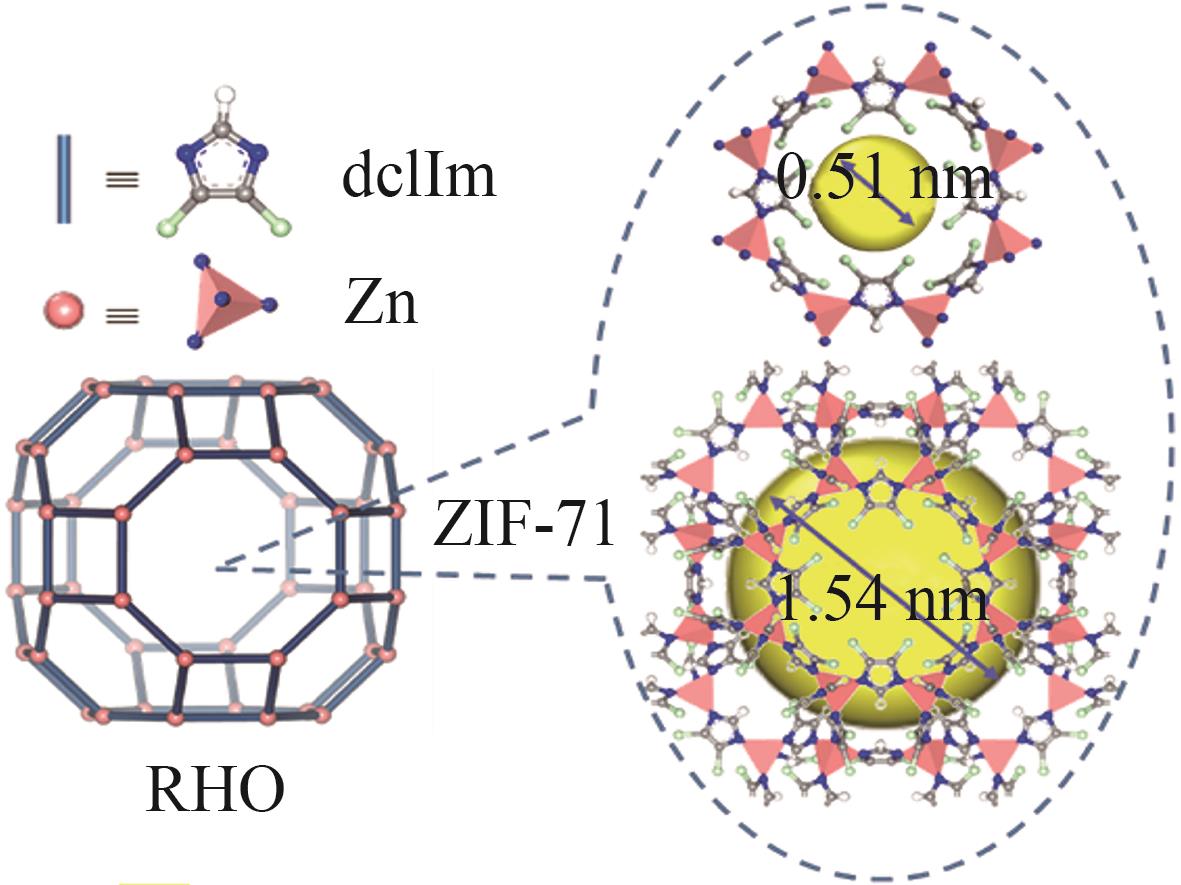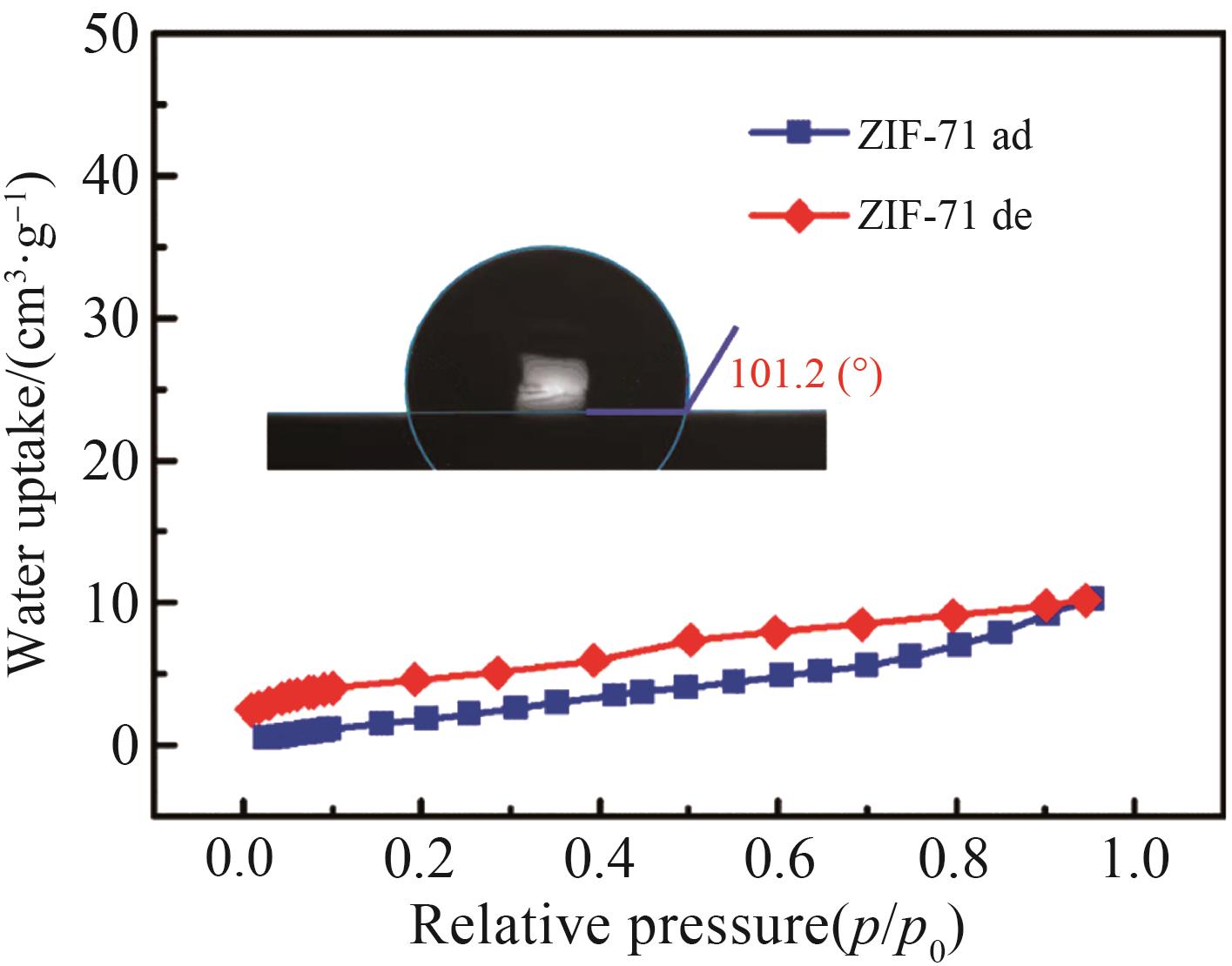
应用化学 ›› 2022, Vol. 39 ›› Issue (11): 1735-1745.DOI: 10.19894/j.issn.1000-0518.220043
沸石咪唑酯骨架结构材料ZIF-71用于低浓度生物基2,3-丁二醇/1,3-丙二醇的吸附分离性能
- 太原理工大学化学工程与技术学院,太原 030024
-
收稿日期:2022-02-21接受日期:2022-05-19出版日期:2022-11-01发布日期:2022-11-09 -
通讯作者:石琪 -
基金资助:国家自然科学基金(21822808)
Zeolitic Imidazolate Framework ZIF‑71 for Adsorption and Separation of 2,3‑Butanediol/1,3‑Propanediol From Dilute Aqueous Solutions
Jian-Shuang ZHANG, Mei-Zhen GAO, Meng-Yao WANG, Qi SHI( ), Jin-Xiang DONG
), Jin-Xiang DONG
- Taiyuan University of Technology,Taiyuan 030024,China
-
Received:2022-02-21Accepted:2022-05-19Published:2022-11-01Online:2022-11-09 -
Contact:Qi SHI -
About author:shiqi594@163.com
-
Supported by:the National Natural Science Foundation of China(21822808)
摘要:
1,3-丙二醇是一种重要的化工原料,生物发酵法生产1,3-丙二醇往往会产生副产物2,3-丁二醇,限制了生物基1,3-丙二醇的进一步工业化应用。1,3-丙二醇与2,3-丁二醇亲水性强,导致其在低浓度发酵液中分离困难。基于2,3-丁二醇比1,3-丙二醇具有长的碳链和大的极化率,本文采用含有―Cl基团(憎水且具有大的极化率)的ZIF-71吸附分离水中低浓度的2,3-丁二醇/1,3-丙二醇。结果表明,ZIF-71对双组分2,3-丁二醇/1,3-丙二醇(50 g/L,50 g/L)中2,3-丁二醇的静态竞争吸附容量为123.6 mg/g,对2,3-丁二醇/1,3-丙二醇分离选择性高达7.6,分离效果优于沸石材料Beta。在3次循环吸附-解吸实验中ZIF-71依旧保持着稳定的结构和对2,3-丁二醇的选择性吸附能力。通过分子模拟,揭示了ZIF-71对1,3-丙二醇和2,3-丁二醇的吸附分离机制。ZIF-71与1,3-丙二醇之间主要通过弱的范德华力作用;而ZIF-71与2,3-丁二醇之间则是通过强的范德华力与弱的氢键协同作用,从而对2,3-丁二醇产生选择性吸附。可以看出, ZIFs材料有望成为选择性吸附分离低浓度副产物2,3-丁二醇的吸附剂,推动生物法制1,3-丙二醇的工业化发展。
中图分类号:
引用本文
张健爽, 高美珍, 王梦瑶, 石琪, 董晋湘. 沸石咪唑酯骨架结构材料ZIF-71用于低浓度生物基2,3-丁二醇/1,3-丙二醇的吸附分离性能[J]. 应用化学, 2022, 39(11): 1735-1745.
Jian-Shuang ZHANG, Mei-Zhen GAO, Meng-Yao WANG, Qi SHI, Jin-Xiang DONG. Zeolitic Imidazolate Framework ZIF‑71 for Adsorption and Separation of 2,3‑Butanediol/1,3‑Propanediol From Dilute Aqueous Solutions[J]. Chinese Journal of Applied Chemistry, 2022, 39(11): 1735-1745.
溶质分子 a Solute molecules | 分子尺寸 b Molecular size/nm3 | 偶极矩 Dipole moment/debye | 极化率 d Polarizability/nm3 |
|---|---|---|---|
H2O 1,3?PDO | 0.39×0.30×0.33 0.81×0.50×0.54 0.76×0.57×0.59 | 1.85[ 2.50[ 1.95 c | 1.00×10-3 6.79×10-3 |
| 2,3?BDO | 8.60×10-3 |
表1 溶质分子和水的分子尺寸、偶极矩和极化率
Table 1 The molecular size, dipole moment and polarizability of solute molecules and water
溶质分子 a Solute molecules | 分子尺寸 b Molecular size/nm3 | 偶极矩 Dipole moment/debye | 极化率 d Polarizability/nm3 |
|---|---|---|---|
H2O 1,3?PDO | 0.39×0.30×0.33 0.81×0.50×0.54 0.76×0.57×0.59 | 1.85[ 2.50[ 1.95 c | 1.00×10-3 6.79×10-3 |
| 2,3?BDO | 8.60×10-3 |

图3 (A)ZIF-71的粉末X射线衍射谱图; (B)ZIF-71的红外表征; (C)ZIF-71的热重曲线; (D)电子显微镜分析ZIF-71的粒径和形貌
Fig.3 (A) PXRD patterns of ZIF-71; (B) FT-IR characterization of ZIF-71; (C) TG curve of ZIF-71; (D) Particle size and morphology of ZIF-71 by SEM
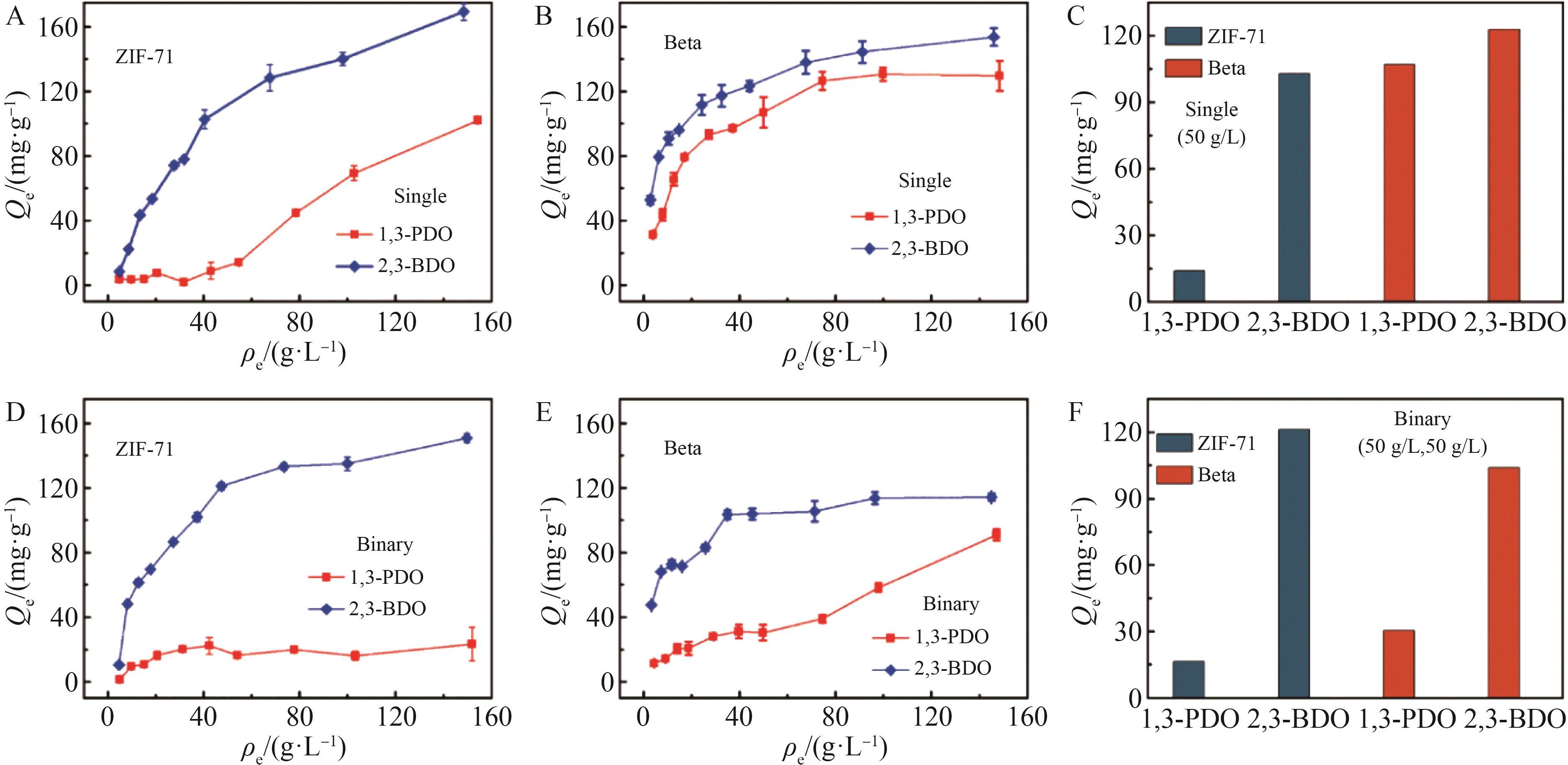
图6 (A) ZIF-71和(B) Beta对1,3-丙二醇和2,3-丁二醇的静态吸附等温线以及(C)静态吸附性能对比; (D) ZIF-71和(E)Beta对1,3-丙二醇/2,3-丁二醇的竞争吸附等温线以及(F)竞争吸附性能对比
Fig.6 Static adsorption isotherms of (A) ZIF-71 and (B) Beta for 1,3-PDO and 2,3-BDO and (C) comparison of static adsorption performance; Competitive adsorption isotherms of (D) ZIF-71 and (E) Beta for 1,3-PDO/2,3-BDO and (F) comparison of competitive adsorption performance
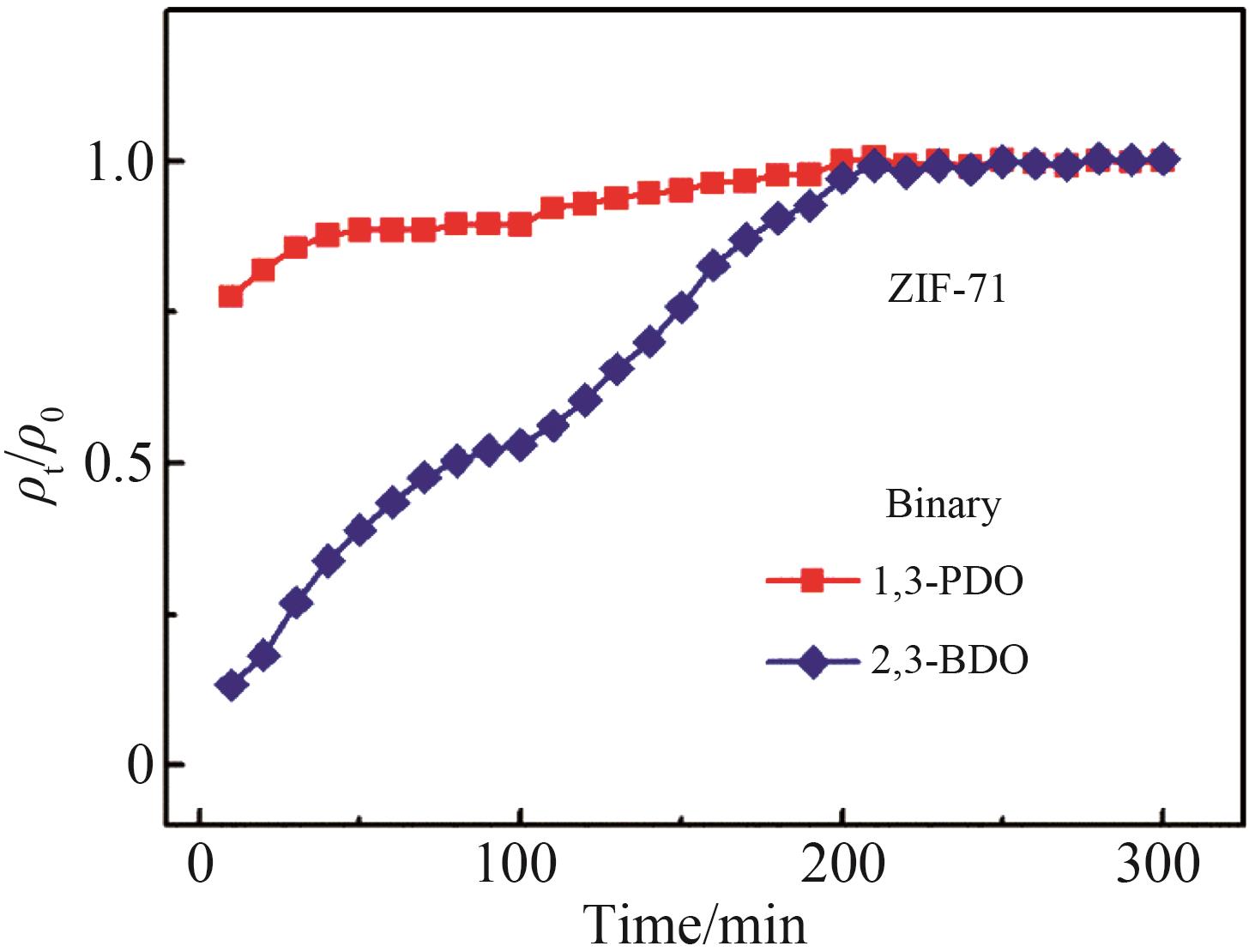
图7 二元组分2,3-丁二醇(50 g/L)/1,3-丙二醇(50 g/L)在ZIF-71上的动态穿透曲线
Fig.7 Adsorption breakthrough curves of binary-component 1,3-PDO (50 g/L) and 2,3-BDO (50 g/L) on ZIF-71
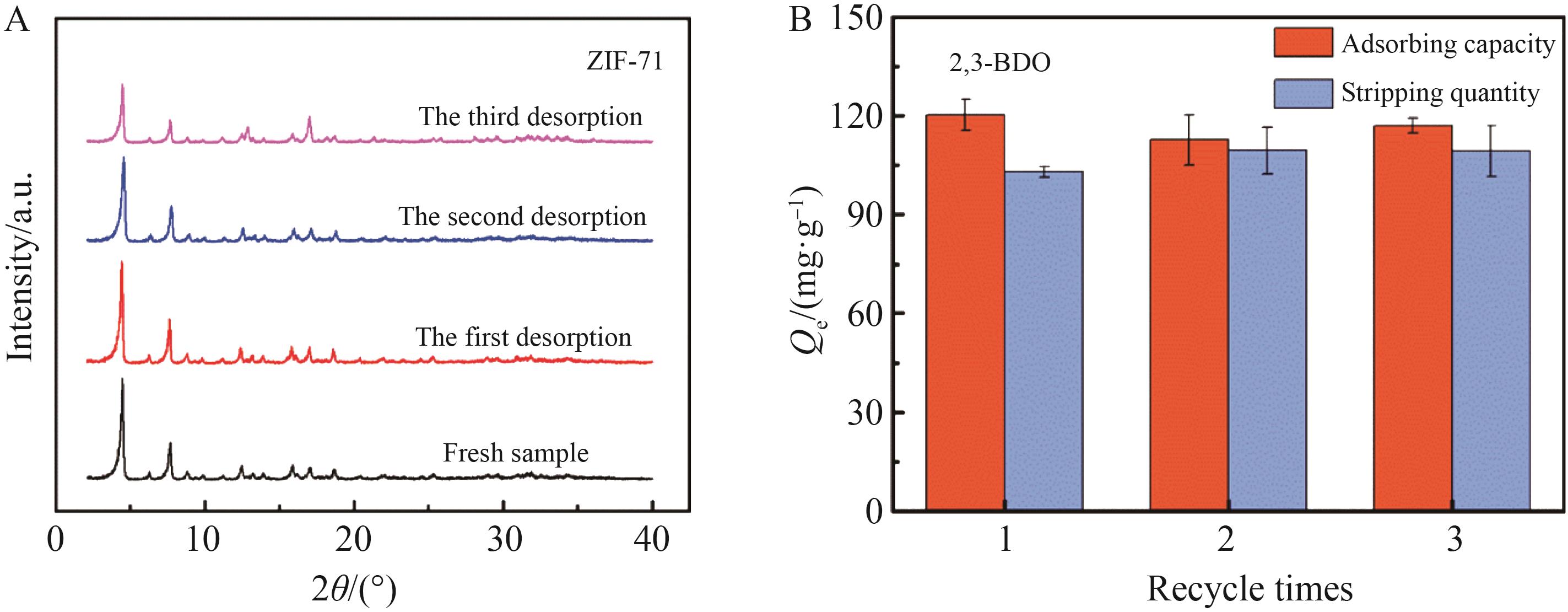
图10 循环吸附-解吸过程中ZIF-71的(A)PXRD谱图和(B)对双组分2,3-丁二醇/1,3-丙二醇(50 g/L, 50 g/L)中2,3-丁二醇的吸附/解吸量
Fig.10 (A) PXRD patterns of ZIF-71 during cyclic adsorption-desorption process and (B) adsorption/desorption capacity of 2,3-BDO in binary components 2,3-BDO/1,3-PDO (50 g/L, 50 g/L)
| 1 | KURIAN J V. A new polymer platform for the future-sorona® from corn derived 1,3-propanediol[J]. J Polym Environ, 2005, 13(2): 159-167. |
| 2 | ZHU Y T, WANG Y X, GAO H, et al. Current advances in microbial production of 1,3-propanediol[J]. Biofuel Bioprod Bior, 2021, 15(5): 1566-1583. |
| 3 | SUN Y Q, SHEN J T, YAN L, et al. Advances in bioconversion of glycerol to 1,3-propanediol: prospects and challenges[J]. Process Biochem, 2018, 71: 134-146. |
| 4 | 余晓兰, 汤建凯. 生物基聚对苯二甲酸丙二醇酯(PTT)纤维研究进展[J]. 精细与专用化学品, 2018, 26(2): 13-17. |
| YU X L, TANG J K. Research progress of bio-based polytrimethylene terephthalate (PTT) fibers[J]. Fine Speci Chem, 2018, 26(2): 13-17. | |
| 5 | 周昱, 姚洁, 王公应. 1,3-丙二醇合成工艺研究进展[J]. 天然气化工, 2006, 31(1): 66-74. |
| ZHOU Y, YAO J, WANG G Y. Research progress on the synthesis process of 1,3-propanediol[J]. Nat Gas Chem Ind, 2006, 31(1): 66-74. | |
| 6 | LARI G M, PASTORE G, HAUS M, et al. Environmental and economical perspectives of a glycerol biorefinery[J]. Energ Environ Sci, 2018, 11(5): 1012-1029. |
| 7 | LIU H J, ZHOU Y J, CAI Z Z, et al. 1,3-Propanediol fermentation with the by-product glycerol from biodiesel production by a genetic modified Klebsiella pneumoniae[J]. Adv Mater Res, 2012, 512-515: 323-329. |
| 8 | XU Y Z, GUO N N, ZHENG Z M, et al. Metabolism in 1,3-propanediol fed-batch fermentation by a D-lactate deficient mutant of klebsiella pneumoniae[J]. Biotechnol Bioeng, 2009, 104(5): 965-972. |
| 9 | PARK J M, RATHNASINGH C, SONG H. Metabolic engineering of Klebsiella pneumoniae based on in silico analysis and its pilot-scale application for 1,3-propanediol and 2,3-butanediol co-production[J]. J Ind Microbiol Biotechnol, 2017, 44(3): 431-441. |
| 10 | NAKAMURA C E, WHITED G M. Metabolic engineering for the microbial production of 1,3-propanediol[J]. Curr Opin Biotech, 2003, 14(5): 454-459. |
| 11 | AMRAOUI Y, NARISETTY V, COULON F, et al. Integrated fermentative production and downstream processing of 2,3-butanediol from sugarcane bagasse-derived xylose by mutant strain of enterobacter ludwigii[J]. ACS Sustain Chem Eng, 2021, 9(30): 10381-10391. |
| 12 | XIU Z L, ZENG A P. Present state and perspective of downstream processing of biologically produced 1,3-propanediol and 2,3-butanediol[J]. Appl Microbiol Biotechnol, 2008, 78(6): 917-926. |
| 13 | CHEN T, CHEN Y Z, BAI P. Recovery of biomass-derived polyols by pressure swing adsorption: experiments, simulations, scale-up implementation and economic analysis[J]. Ind Eng Chem Res, 2020, 59(17): 8323-8334. |
| 14 | MITREA L, LEOPOLD L F, BOUARI C, et al. Separation and purification of biogenic 1,3-propanediol from fermented glycerol through flocculation and strong acidic ion-exchange resin[J]. Biomolecules, 2020, 10(12): 1601. |
| 15 | ZHANG C J, SHARMA S, WANG W, et al. A novel downstream process for highly pure 1,3-propanediol from an efficient fed-batch fermentation of raw glycerol by Clostridium pasteurianum[J]. Eng Life Sci, 2021, 21(6): 351-363. |
| 16 | BASTRZYK J, GRYTA M, KARAKULSKI K. Fouling of nanofiltration membranes used for separation of fermented glycerol solutions[J]. Chem Pap, 2014, 68(6): 757-765. |
| 17 | 周雯, 佟珊珊. 新型吸附材料分离和富集贵金属的研究进展[J]. 应用化学, 2021, 38(8): 897-910. |
| ZHOU W, TONG S S. Research progress on novel adsorbent materials for separation and enrichment of noble metals[J]. Chinese J Appl Chem, 2021, 38(8): 897-910. | |
| 18 | TAN S J, LIU L, CHEW J W. Competitive and synergistic adsorption of mixtures of polar and nonpolar gases in carbonaceous nanopores[J]. Langmuir, 2021, 37(22): 6754-6764. |
| 19 | GUNZEL B, BERKE C H, ERNST S, et al. Adsorption von diolen aus fermentationsmedien an hydrophobe zeolithe[J]. Chem Ing Tech, 1990, 62(9): 748-750. |
| 20 | SCHLIEKER H, GUNZEL B, DECKWER W D. Einsatz der adsorption zur produktabtrennung bei der glycerinvergarung zu 1,3-propandiol[J]. Chem Ing Tech, 1992, 64(8): 727-728. |
| 21 | WANG Z, WU Z, TAN T W. Sorption equilibrium, mechanism and thermodynamics studies of 1,3-propanediol on beta zeolite from an aqueous solution[J]. Bioresour Technol, 2013, 145: 37-42. |
| 22 | 苏建英, 吴家鑫, 谭天伟. 疏水硅沸石吸附1,3-丙二醇的研究[J]. 化学工程, 2007, 35(5): 1-4. |
| SU J Y, WU J X, TAN T W. Study on adsorption of 1,3-propanediol by hydrophobic silicalite[J]. Chem Eng,2007, 35(5): 1-4. | |
| 23 | LI G, LIU W, WANG X, et al. Separation of 2,3-butanediol using ZSM-5 zeolite modified with hydrophobic molecular spaces[J]. Chem Lett, 2014, 43(4): 411-413. |
| 24 | PIMENTEL B R, PARULKAR A, ZHOU E K, et al. Zeolitic imidazolate frameworks: next-generation materials for energy-efficient gas separations[J]. ChemSusChem, 2014, 7(12): 3202-3240. |
| 25 | CHEN F, LAI D, GUO L, et al. Deep desulfurization with record SO2 adsorption on the metal-organic frameworks[J]. J Am Chem Soc, 2021, 143(24): 9040-9047. |
| 26 | WANG Q, ASTRUC D. State of the art and prospects in metal-organic framework (MOF)-based and MOF-derived nanocatalysis[J]. Chem Rev, 2020, 120(2): 1438-1511. |
| 27 | 田龙, 豆维新, 杨玮婷, 等. 不同尺寸ZIF-8对U(VI)的吸附性能[J]. 应用化学, 2021, 38(1): 84-91. |
| TIAN L, DOU W X, YANG W T, et al. Size effect of ZIF-8 on the adsorption of uranium[J]. Chinese J Appl Chem, 2021, 38(1): 84-91 | |
| 28 | JIN H, LI Y S, YANG W S. Adsorption of biomass-derived polyols onto metal-organic frameworks from aqueous solutions[J]. Ind Eng Chem Res, 2018, 57(35): 11963-11969. |
| 29 | LI J R, KUPPLER R J, ZHOU H C. Selective gas adsorption and separation in metal-organic frameworks[J]. Chem Soc Rev, 2009, 38(5): 1477-1504. |
| 30 | 徐如人, 庞文琴, 于吉红, 等. 分子筛与多孔材料化学[M]. 北京: 科学出版社, 2004: 204-205. |
| XU R R, PANG W Q, YU J H, et al. Molecular sieves and porous materials chemistry[M]. Beijing: Science Press, 2004: 204-205. | |
| 31 | JORGENSEN W L, CHANDRASEKHAR J, MADURA J D, et al. Comparison of simple potential functions for simulating liquid water[J]. J Chem Phys, 1983, 79(2): 926-935. |
| 32 | WEE L H, VANDENBRANDE S, ROGGE S M J, et al. Chlorination of a zeolitic-imidazolate framework tunes packing and van der Waals interaction of carbon dioxide for optimized adsorptive separation[J]. J Am Chem Soc, 2021, 143(13): 4962-4968. |
| 33 | ZHANG K, NALAPARAJU A, CHEN Y, et al. Biofuel purification in zeolitic imidazolate frameworks: the significant role of functional groups[J]. Phys Chem Chem Phys, 2014, 16(20): 9643-9655. |
| 34 | WANG F, YANG H, KANG Y, et al. Guest selectivity of a porous tetrahedral imidazolate framework material during self-assembly[J]. J Mater Chem, 2012, 22(37): 19732-19737. |
| 35 | PHAN A, DOONAN C J, URIBE-ROMO F J, et al. Synthesis, structure, and carbon dioxide capture properties of zeolitic imidazolate frameworks[J]. Acc Chem Res, 2010, 43(1): 58-67. |
| 36 | BANERJEE R, PHAN A, WANG B, et al. High-throughput synthesis of zeolitic imidazolate frameworks and application to CO2 capture[J]. Science, 2008, 319(5865): 939-943. |
| 37 | Dassault Syst′emes BIOVIA, Materials studio modeling environment, release 2017, Dassault Systemes BIOVIA[CP]. San Diego, CA, 2016. |
| 38 | LIU S, LIU G, ZHAO X, et al. Hydrophobic-ZIF-71 filled PEBA mixed matrix membranes for recovery of biobutanol via pervaporation[J]. J Membr Sci, 2013, 446: 181-188. |
| 39 | MORTADA B, CHAPLAIS G, NOUALI H, et al. Phase transformations of metal-organic frameworks MAF-6 and ZIF-71 during intrusion-extrusion experiments[J]. J Phy Chem C, 2019, 123(7): 4319-4328. |
| 40 | YOO D K, BHADRA B N, JHUNG S H. Adsorptive removal of hazardous organics from water and fuel with functionalized metal-organic frameworks: contribution of functional groups[J]. J Hazard Mater, 2021, 403: 123655. |
| 41 | ZHU Z, XU H, JIANG J, et al. Hydrophobic nanosized all-silica beta zeolite: efficient synthesis and adsorption application[J]. ACS Appl Mater Interfaces, 2017, 9(32): 27273-27283. |
| [1] | 杨玉雯, 齐婧瑶, 李林, 楚国宁, 王赛, 张钰, 张爽. 磁性NiFe2O4负载Ru催化5-羟甲基糠醛选择性氧化合成2,5-呋喃二甲酸[J]. 应用化学, 2023, 40(6): 879-887. |
| [2] | 元宁, 马洁, 张晋玲, 张建胜. 蒸气辅助合成PCN-6(M)双金属有机框架材料及其CH4和CO2吸附性能[J]. 应用化学, 2023, 40(6): 896-903. |
| [3] | 修海祥, 刘万强, 尹东明, 程勇, 王春丽, 王立民. AB2型Laves相储氢合金研究进展[J]. 应用化学, 2023, 40(5): 640-652. |
| [4] | 杨林, 潘卉, 郜定峰, 王晓冬. 芳纶改性聚合物基纳米复合皮革涂饰剂的制备和性能[J]. 应用化学, 2023, 40(5): 708-719. |
| [5] | 方愈, 况王强, 邝圣庭, 廖伍平. Cextrant 230从低品位铜矿H2SO4-NaCl浸出液中选择性提取回收铜[J]. 应用化学, 2023, 40(5): 758-768. |
| [6] | 李谋翠, 董洋铭, 任莹辉, 马海霞, 齐乐. 含1,2,4-三唑双席夫碱衍生物的合成、抗菌活性及分子对接[J]. 应用化学, 2023, 40(1): 116-125. |
| [7] | 成燕琴, 黎卓熹, 王有娣, 徐娟娟, 卞证. 结构简单的4-羟基脯氨酰胺高效催化醛和硝基烯不对称迈克尔加成反应[J]. 应用化学, 2023, 40(1): 146-154. |
| [8] | 郭佳昕, 刘洋, 徐长山, 刘晓男, 程亮. 不同pH值下MgO NPs悬浮液中Mg2+质量浓度的动态变化及其对小麦生长的影响[J]. 应用化学, 2022, 39(9): 1401-1411. |
| [9] | 王恩通, 杨林芳. 高比容量锂离子电池正极材料LiNi0.6Co0.2Mn0.2O2的制备及性能[J]. 应用化学, 2022, 39(8): 1209-1215. |
| [10] | 唐连波, 付大友, 陈琦, 奉阳润, 熊桠林, 王竹青. 碳量子点增强气液相化学发光检测二氧化碳[J]. 应用化学, 2022, 39(8): 1294-1302. |
| [11] | 王兵, 唐敏, 王颖, 刘志光. 微氧化烧结制备掺杂Y2O3的SiC陶瓷及含镉模拟废水处理[J]. 应用化学, 2022, 39(8): 1312-1318. |
| [12] | 杨雪贤, 张健, 谷志刚. 表面配位金属-有机框架薄膜HKUST-1在光电应用中的研究进展[J]. 应用化学, 2022, 39(7): 1013-1025. |
| [13] | 张晓丽, 彭玉美, 王庆伟, 秦利霞, 刘肖霞, 康诗钊, 李向清. 纳米Ag/TiO2纳米管阵列基底构建及表面增强拉曼散射光谱检测与降解盐酸四环素[J]. 应用化学, 2022, 39(7): 1147-1156. |
| [14] | 张超. 单原子催化剂电催化还原二氧化碳研究进展[J]. 应用化学, 2022, 39(6): 871-887. |
| [15] | 杨琴, 陈宁华, 张宇杰, 叶芝祥, 杨迎春. 铈锆复合氧化物修饰电极的制备及用于水样中Pb2+的检测[J]. 应用化学, 2022, 39(6): 990-999. |
| 阅读次数 | ||||||
|
全文 |
|
|||||
|
摘要 |
|
|||||

